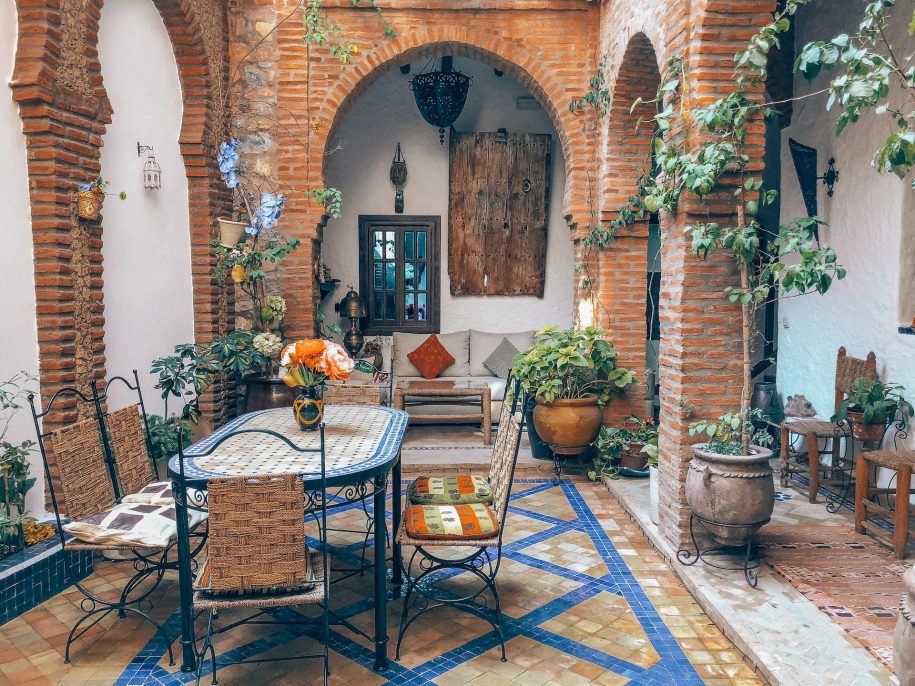After purchasing your trip to Morocco, you must choose a place to stay. After all, during your trip to Morocco, you’ll need a somewhere to stay, take a shower, and unwind in between riding camels on the beach, buying handmade carpets, and eating couscous, Even though the nation is home to several chain hotels and opulent resorts, every traveler should seriously consider staying at least a few nights in a Moroccan Riad. What Exactly Is a Riad
So, Exactly What Is a Riad
A riad, which translates to “garden” in Arabic, was originally a Moroccan house built for. the privacy of a large family In raids rooms are erected tall and tightly around a courtyard or atrium, facing inward and opening inward Never judge a book by its cover applies well to the riad From the outside it could appear to be a barren brick or mud clay wall, a veritable fortress with a substantial entrance and no outside windows, You may be greeted at entry by floral scents and the bubbling of a fountain in the courtyard.
Moroccan riads are a designer and architect’s dream and, for the most part, live up to instagram standards. They are the epitome of the Moroccan experience, frequently including rose petals and cozy nooks. The interior gardens and multicolored tiles, which were typically havens of cool shelter where the women of the house performed the most of their socializing, were scented with jasmine and orange blossom. Naturally, traditional riads lacked flowing water. The neighborhood hammam, or bathhouse, was where the locals took their baths.
Thankfully, many of the historic structures have undergone renovations and updates that include both contemporary necessities and all the original aesthetic elements, making them ideal for overnight visitors. Plumbing and running water are of course necessities, as are rooftop gardens, restaurants, spas, and bubbling fountains. A riad can be purchased for any price point between cheap and hyper spend. Some riads are so opulent and extravagant that they are worth a trip just to see them. There are numerous of these upscale riads available to the public for a rooftop martini in the evening or a house specialty tajine for lunch if your budget doesn’t stretch to luxury.
Choosing A Riad
Even after narrowing down your alternatives to fit comfortably inside your budget, you probably still won’t run out of possibilities. In spite of the fact that there are so many gorgeously refurbished riads, there are a few things to bear in mind while trying to arrange the ideal Moroccan vacation, Choose a riad with the ideal courtyard plunge pool if you will be in Marrakesh in the middle of the summer. It might get chilly in Fez during the winter, so make sure the accommodation has a heater or a fireplace. In Moroccan riads, staying cool in the summer usually takes precedence over staying warm in the winter.
Another important factor to take into account when making a reservation is location. Try to determine how central, if at all, the riad is. Is it close to the popular institution on your agenda or the restaurant you’ve been wanting to try? If you plan to drive yourself, ask the riad about parking options. In and around a medina, parking is scarce, so plan on paying for overnight parking.
However, here is where the central courtyard design comes into play, as the rush and bustle of outside might pass by unnoticed while you drink your mint tea behind closed doors. Some portions of the medina can be particularly noisy at night if positioned on a major plaza or through road.
Expectations for Your Riad
The riad’s design is intended to maintain a cool environment. The riads are often built with high ceilings and few windows in locations like Marrakesh and Fes, where it may get quite hot in the middle of the summer. As a result, don’t anticipate being able to throw open your windows and gaze out upon the medina. A/C use is unnecessary unless on the warmest of days thanks to the courtyard’s fountains and high walls, which together help to chill the air. The impassable walls that define the riads of Marrakesh will be punctured by more outward-facing windows along the coast, in locations like Essaouira, allowing the sea air to enter the courtyard. Additionally, coastal riads frequently have lighter, brighter interiors with less high ceilings that are needed to maintain cool temperatures in the bedrooms. Architectural styles and detail will vary from town to town depending on local materials, the climate, and the history, even if fundamental riad qualities are consistent across the nation. The architecture of coastal cities frequently reflects historical ties to the Spanish or Portuguese whereas Marrakesh’s red and ochre walls have a desert-inspired design.
Interior Design in a Riad
You could discover a treasure trove of Moroccan crafts on the walls, floors, ceilings, and even the floors of your riad because restoration has been a fundamental component of many renovations Tadelakt plaster, stucco accents, and zellij tiles are likely to be used to decorate the riad. The Moroccan riad lifestyle includes handcrafted lamps, carved and painted wooden doors. and woven rugs, so your riad is much more than simply a place to leave your bags before exploring the medina.
How a Dar Changes Everything
A few more adjectives that describe the type and location of accommodations being given might be found while looking for the ideal spot to stay. Some people could utilize the word “Dar” as a prefix while investigating the available riads. While “riad” refers to a garden, the word “dar” is more directly translated as “house,” and historically, this word referred to a little more basic building with a central courtyard rather than a garden. It will have many stories and is oriented inward like a riad, with rooms opening into the courtyard. The courtyard of the dar is likely to be filled with fountains and aromatic plants even without a formal garden. The distinctions between the dar and the riad are hazy. and both provide the traditional architectural features and way of life that will add charm to your vacation to Morocco.


Leave a Reply